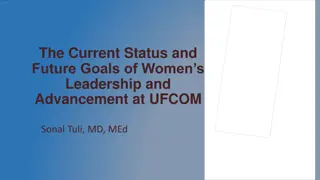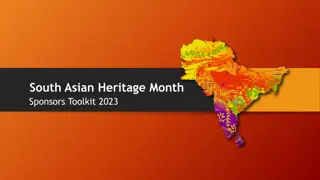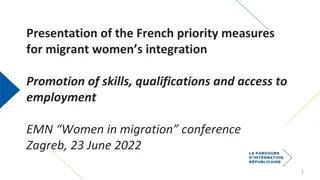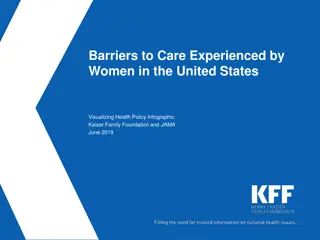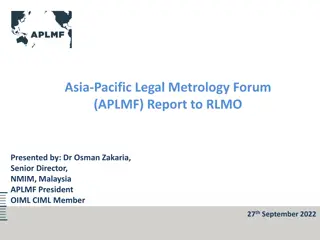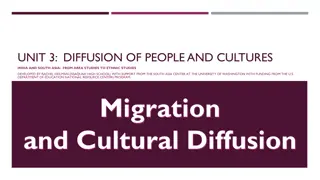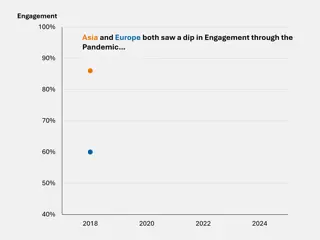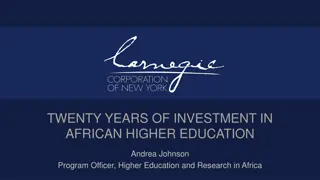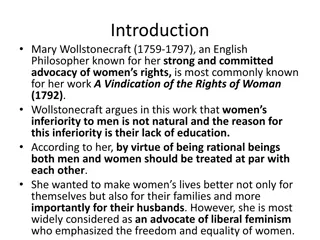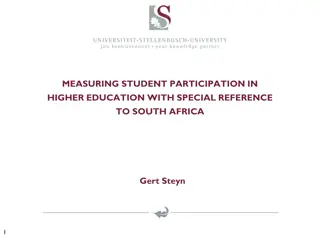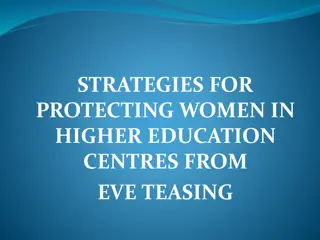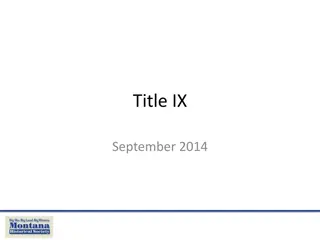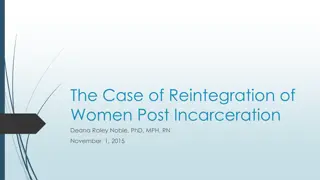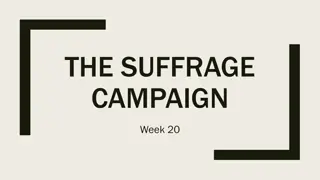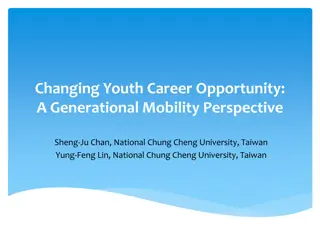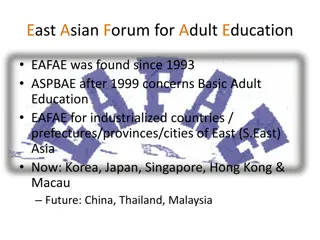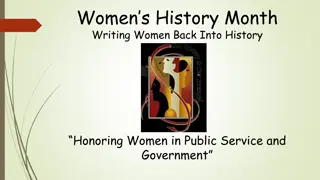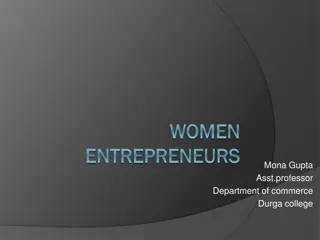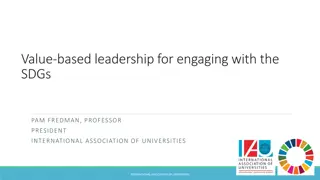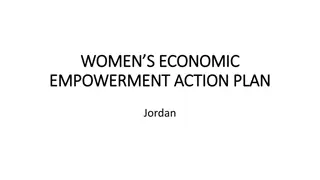Women in Higher Education: Challenges and Opportunities in South Asia
This study by Professor Louise Morley and Dr. Barbara Crossouard explores the complexities surrounding women's leadership in higher education in South Asia. It delves into issues of diversity, democratisation, and difference, shedding light on the barriers women face in entering leadership positions. The research uncovers the biases and silences within policies and practices that hinder gender equality in academia. Through a critical lens, the authors analyze the affective economy of leadership, the lack of gender-disaggregated statistics, and the personal experiences of women leaders. The study calls for a re-examination of current practices to promote gender inclusivity in higher education leadership.
Download Presentation

Please find below an Image/Link to download the presentation.
The content on the website is provided AS IS for your information and personal use only. It may not be sold, licensed, or shared on other websites without obtaining consent from the author. Download presentation by click this link. If you encounter any issues during the download, it is possible that the publisher has removed the file from their server.
E N D
Presentation Transcript
Women in Higher Education Diversity, Democratisation and Difference: Theories and Methodologies Leadership in South Asia: Rejection, Refusal,Reluctance, Re-visioning Professor Louise Morley Dr Barbara Crossouard Centre for Higher Education and Equity Research (CHEER) University of Sussex, UK http://www.sussex.ac.uk/education/cheer
Provocations: Identifying Women Leaders What is it that people don t see? Why don t they see it? What do current practices reveal and obscure?
Making Women Intelligible as Leaders: A Two-Way Gaze? How are women being seen e.g. as deficit men? How are women viewing leadership e.g. unliveable lives? What narratives circulate about: women s capabilities? leadership?
The Affective Economy of Higher Education Leadership Affect Historically dismissed in Western thought Devalued in binary thinking Revisited in post-structural writers (Ahmed 2004, 2010) Sticks to objects and bodies e.g. shame, hatred, love Works as a form of capital/ affective economy Is intensified / accrues value through circulation Integral to the production of social and material realities.
Evidence Literature and Policy Review Statistical Review 30 Interviews (19 women and 11 men) Afghanistan, Bangladesh, India, Nepal, Pakistan, Sri Lanka. What makes leadership attractive/unattractive to women? What enables/ supports women to enter leadership positions? Personal experiences of being enabled/ impeded from entering leadership?
Where are the Women? Lack of Gender-Disaggregated Statistics No linear trends in women s representation Numbers of female academics have increased Gender distribution of male to female academics unchanged Significant differences by disciplinary field of studies Absent from Senior Leadership
Policy Silences Gender = category of analysis for female students, not staff. Quality, not Equality = knowledge economy, good governance, STEM, digital economy. Lack of Research-based Evidence.
Where are the Women? Academic staffing of HEIs in Afghanistan, 2004-2012, data courtesy of British Council Male Female Total 4000 3519 3500 3159 3023 2842 3000 Numbers of female academics have increased 3009 (85.5) 2572 2408 2500 2680 (84.8) 2567 (84.9) 2090 2423 (85.3) 1978 1886 2000 2181 (84.8) 2035 (84.5) No linear trends in women s representation 1774 (84.9) 1500 1676 (84.7) 1613 (85.5) 1000 510 (14.5) 479 (15.2) 456 (15.1) 419 (14.7) 391 (15.2) 373 (15.5) 316 (15.1) 302 (15.3) 273 (14.5) 500 Gender distribution of male to female academics unchanged 0 2004 2005 2006 2007 2008 2009 2010 2011 2012
Where are the Women? % of Female Academics per Field of Study 2012 2011 2010 41.0 42.0 Humanities and Social Science 37.7 30.1 UGC Sri Lanka, 2010, 2011, 2012 Engineering, Manufacturing and Construction 33.6 29.8 48.2 46.8 Business, Admin and Law 45.6 Significant differences by disciplinary field of studies 49.7 50.0 Health and Welfare 52.7 40.9 40.1 Arts 39.1 45.2 44.2 Science and Tech 44.1 No linear trends in women s representation 0.0 10.0 20.0 30.0 40.0 50.0 60.0
Where are the Women? % of Female Academics by academic position 60 53.4 53.5 51.6 50 41.9 UGC Sri Lanka, 2010, 2011, 2012 38.4 38 37.4 40 32.9 31.7 27 26 30 24.4 Women equally represented only at lecturer level 20 10 0 Significant gender inequalities continuing at all other levels Professor Associate Professor Senior Lecturer Lecturer 2010 2011 2012
Women Vice-Chancellors: Leading or Being Led? UK NOR INDIA NEPAL PAK SRI LANKA 17% 31.8% 3% 0% 0.04% 21.4%
Narrating Difference Recruitment and Selection (Political/lacking transparency) Passionate attachment (Disciplines/ research) Authority (Does not stick to women) Gendered Divisions of Labour (Women = domestic domain) Exclusionary Networks (Male Domination/ sexual propriety) Hostile cultures (Toxic/ stressful)
Men Cloning Themselves I think it s to do with liking this gender power relationship. Some of the seniormale academics who always want to have it go, even for an acting position, to another male I think it is something to do with this gender power relationship A lot of males in Sri Lanka believe that for women administrationis not right. (Female Dean, Sri Lanka) They are used to seeing men as leading, right? So they are uncertain how will it be if it is a woman? Because they have not seen many. So I think it s a fear of uncertainty. And the society is not ready to take that risk so a known evil is better than unknown. (Female Professor, Sri Lanka)
Entitlement Cultures and Knowing One s Place The men they also do not like the female to be a leader, that I have also faced the problem They want to see the male as the leader, not the female. (Female Dean, Nepal) I have presented three papers abroad People get jealous instead of feeling pride that s she growing I realised that people are so jealous of peoplewho, especially women, who were growing and getting out of the institution. (Female Senior Lecturer, Pakistan)
Passionate Attachments to Research So there was one Senior Professor I was talking to, a very dynamic lady, very good researcher and internationally known and I said: Why are you not taking Headship of the Department? and she says: It is too much of headache, too much of politics to manage and this will hamper my research. This will hamper my work/life balance , and she says: Anyway I m not inclined okay? (Female Director, India) I have been advised that I should forget about my disciplinary advances,which I'm not ready to, as yet, let go, so. I think for the next five years I willstill trade off or balance these two roles. If I had the choice of moving toanother place as a director and leave my lab behind, I don't think I'm readyfor that. I would continue doing my research and work in the lab. (Female Dean, India)
Self-doubt and Isolation You have to keep proving every time yourself okay? Whereas somebody sits in that position of power, he need not prove, but a lady has to prove every time. (Female Director, India) I think it s the burden and the stress of working in a senior leadership position, which makes it unattractive. Most of the people and most of the women realise that it s a very lonely job up there. (Female Registrar, Pakistan) I'm alone, even today I'm the only university-wide woman dean, I'm the onlywoman in the series of directors, deputy directors, university-wide deans andassociate deans then in these evenings when there's a networking dinner,you are completely left out. (Female Dean, India)
Corruption Fears Also in Sri Lanka this administration is somehow a dirty game Rightly or wrongly, many of them are blamed for financial irregularities and things like that so I think women are more sensitive. We might be thinking okay, why go into that mess?...Corruption leading to all kinds of remarks and all kinds of things like that. (Female Professor, Sri Lanka) I think that good governance should be there the governing body. Some of the members are from the government officials, so there is also chance of the corruption there ...So these kinds of policies personal interest, government affiliations, political affiliations, also the politics, these are the factors, you know, that discourage the women to come to the higher leadership positions. (Male Assistant Professor, Pakistan)
Gendered Dispositions This stereotype definition of leadership, probably that is what matters. . But the way society understands is probably for certain roles a person has to be really aggressive or something, which the woman could have handled in a different way, not showing that kind of aggression per se. But then you are not selected for the role in the interview if you don t look like you can kill something (Female Assistant Professor, India)
Gendered Divisions of Labour I need to spend about 8 hours a day just on administration, on really quite useless things. And of course I also have my research however in my situation, as a man I can manage both, and spend time on those other aspects when I get home. However, when a woman gets home, she is involved with the family so women will avoid those kinds of admin posts they are doing very well as associate professors, as assistant professors, as students, as doctoral students, but their inclination is to the family, and not to put themselves forward for these kinds of posts where there is a lot of administration. (Male Head of Department, Pakistan)
Gender Appropriate Behaviour There is not closed culture for the men, they are free to go outside but thewomen cannot because it s prohibited in some place of my country, for thewomen go alone abroad without their husband. (Female Vice Dean, Afghanistan) You know a woman if she s networking and lobbying then immediately she s branded as being very ambitious and very pushy. (Female Pro-Vice Chancellor, Bangladesh) One of our PVCs dresses quite flamboyantly you know, wearing trousers is frowned upon in the university... So now, when she applied for the VCship, she stopped wearing trousers and got a sari. So I want a place where you don t have to make such choices, make such compromises. (Female Professor, Sri Lanka)
What Attracts Women to Senior Leadership? Power Influence Values Rewards Recognition
Why is Senior Leadership Unattractive to Women? Neo-liberalism/ Performance Cultures Being Other in male-dominated cultures Disrupting the symbolic order Corruption/ Financialisation Pre-determined Scripts Women lack capital (economic, political, social and symbolic) to redefine the requirements of the field?
Barriers Enablers Internationalisation Policies (affirmative action, gender mainstreaming, work/life balance) Women-only Provision (leadership development/ universities) Mentoring Professional Development Family Evidence (Research/ Gender-Disaggregated Statistics) The Power of the Socio- Cultural/ Gender Appropriate Social Class and Caste Lack of Investment in Women Organisational Cultures Perceptions of Leadership Recruitment and Selection Family Gender and Authority Corruption
Moving On Women are Rejected Refusing/ Self Excluding Reluctant Change Not representation alone/ counting more women into existing structures/ systems. Need for Re-visioning of Leadership- more generative, generous and gender-free.
Follow Up? Morley, L. & Crossouard, B. (2015) Women in Higher Education Leadership in South Asia: Rejection, Refusal, Reluctance, Revisioning. Pakistan: British Council. https://www.sussex.ac.uk/webteam/gateway/file.php?name=women-in- higher-education-leadership-in-south-asia---full-report.pdf&site=41 Morley, L. et al. (in press, 2015) Managing Modern Malaysia: Women in Higher Education Leadership. In, Eggins, H. (Ed) The Changing Role of Women in Higher Education: Academic and Leadership Challenges. Dordrecht: Springer Publications. Morley, L. (I2014) Lost Leaders: Women in the Global Academy. Higher Education Research and Development 33 (1) 111 125. Morley, L. (2013) "The Rules of the Game: Women and the Leaderist Turn in Higher Education " Gender and Education. 25(1):116-131. Morley, L. (2013) Women and Higher Education Leadership: Absences and Aspirations. Stimulus Paper for the Leadership Foundation for Higher Education. Morley, L. (2013) International Trends in Women s Leadership in Higher Education In, T. Gore, and Stiasny, M (eds) Going Global. London, Emerald Press.








